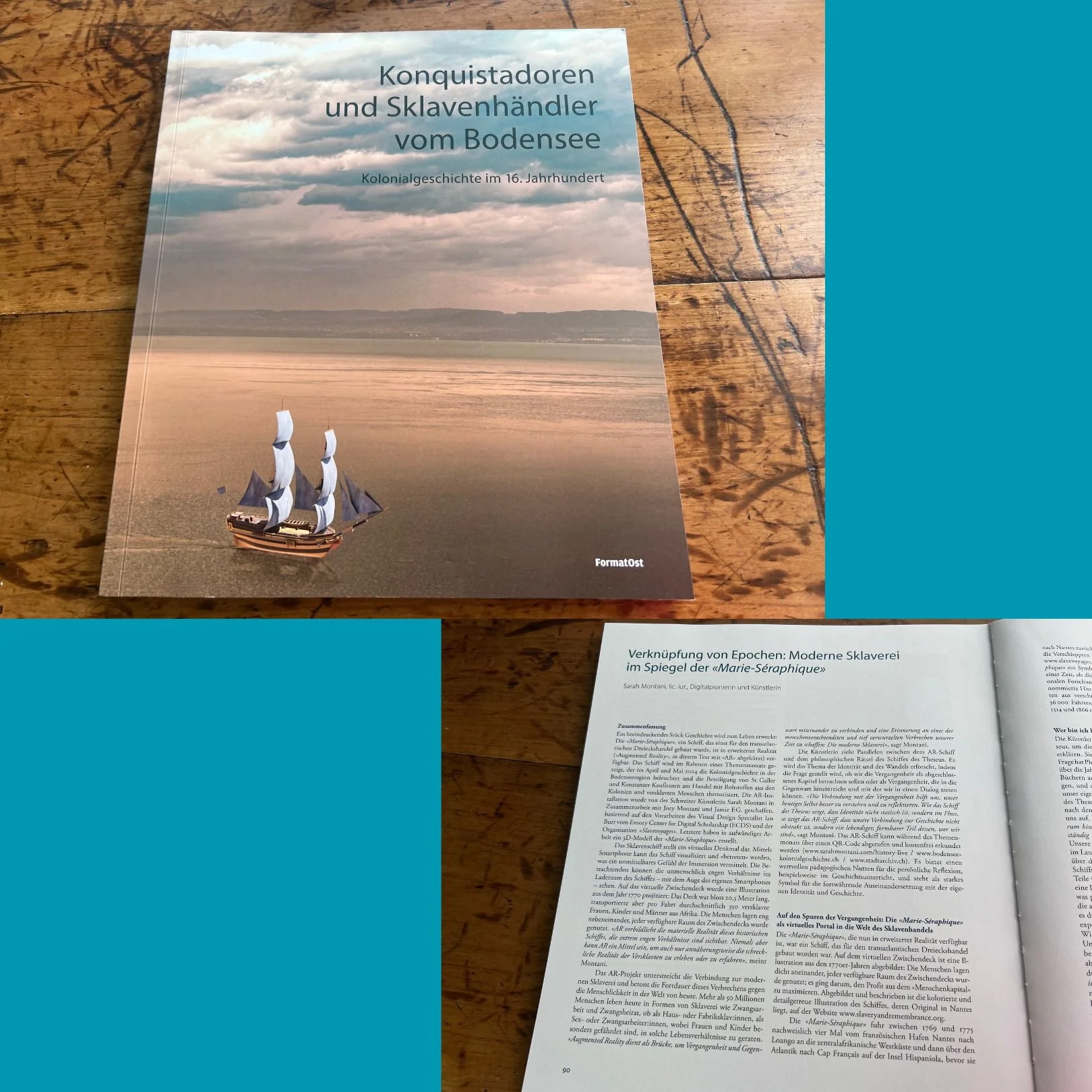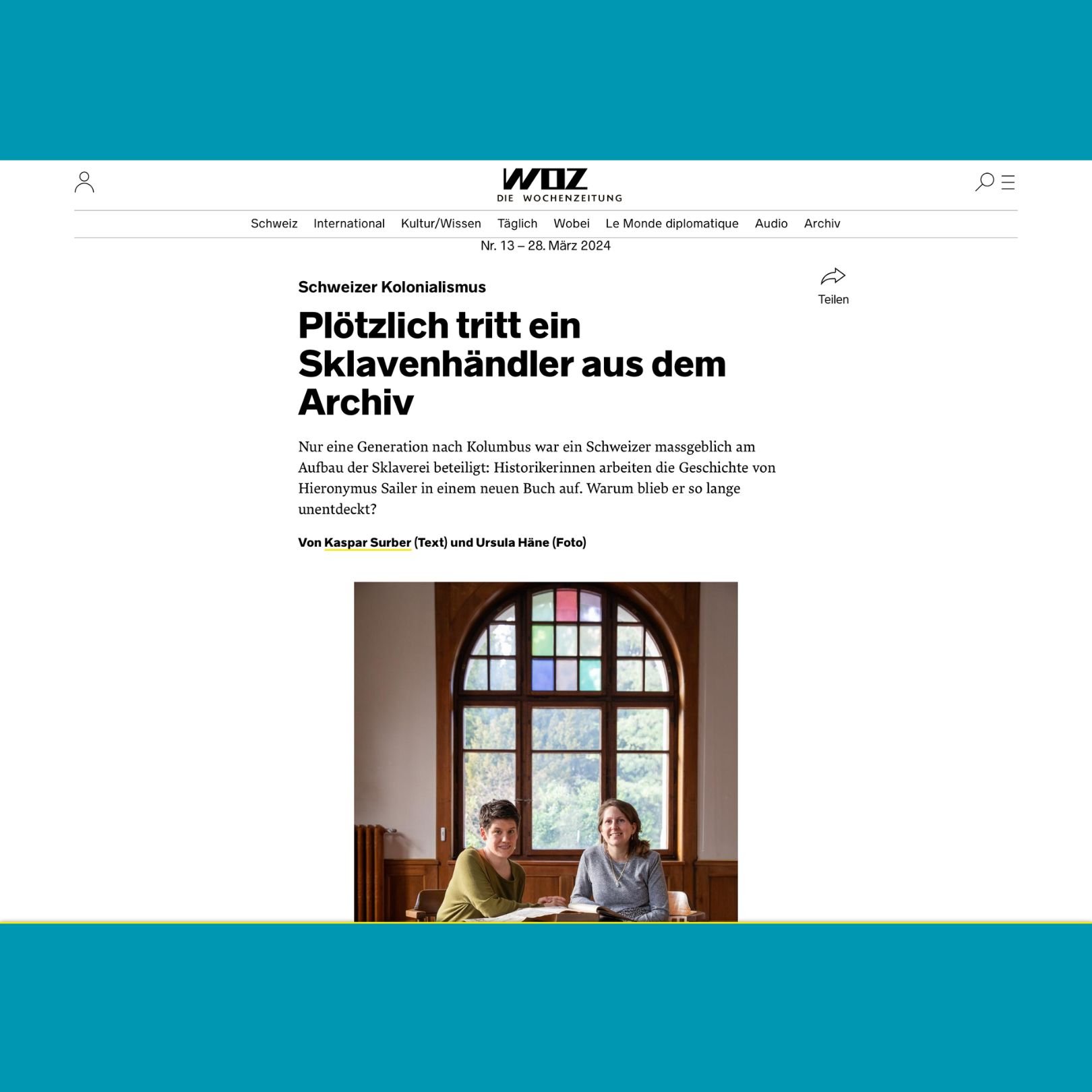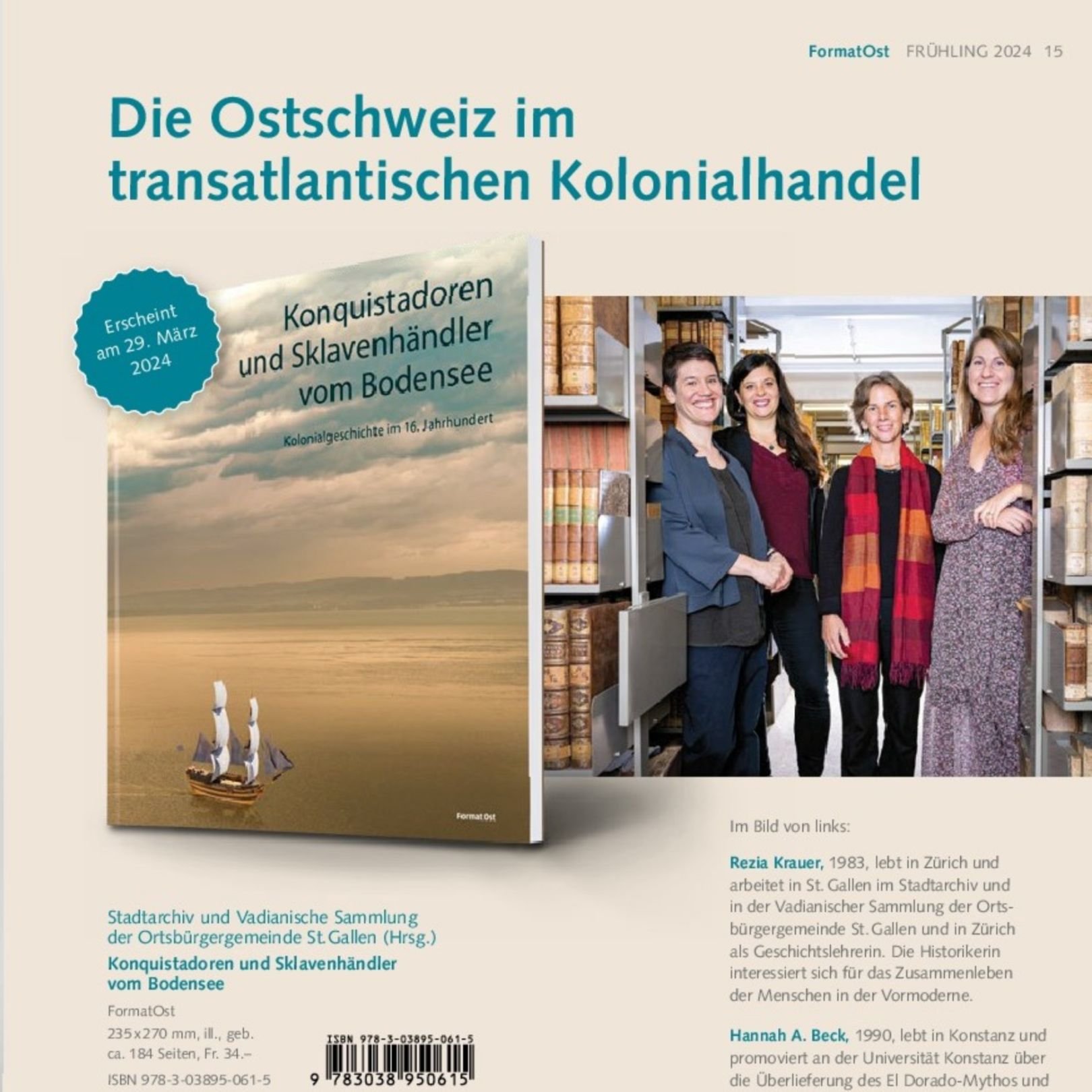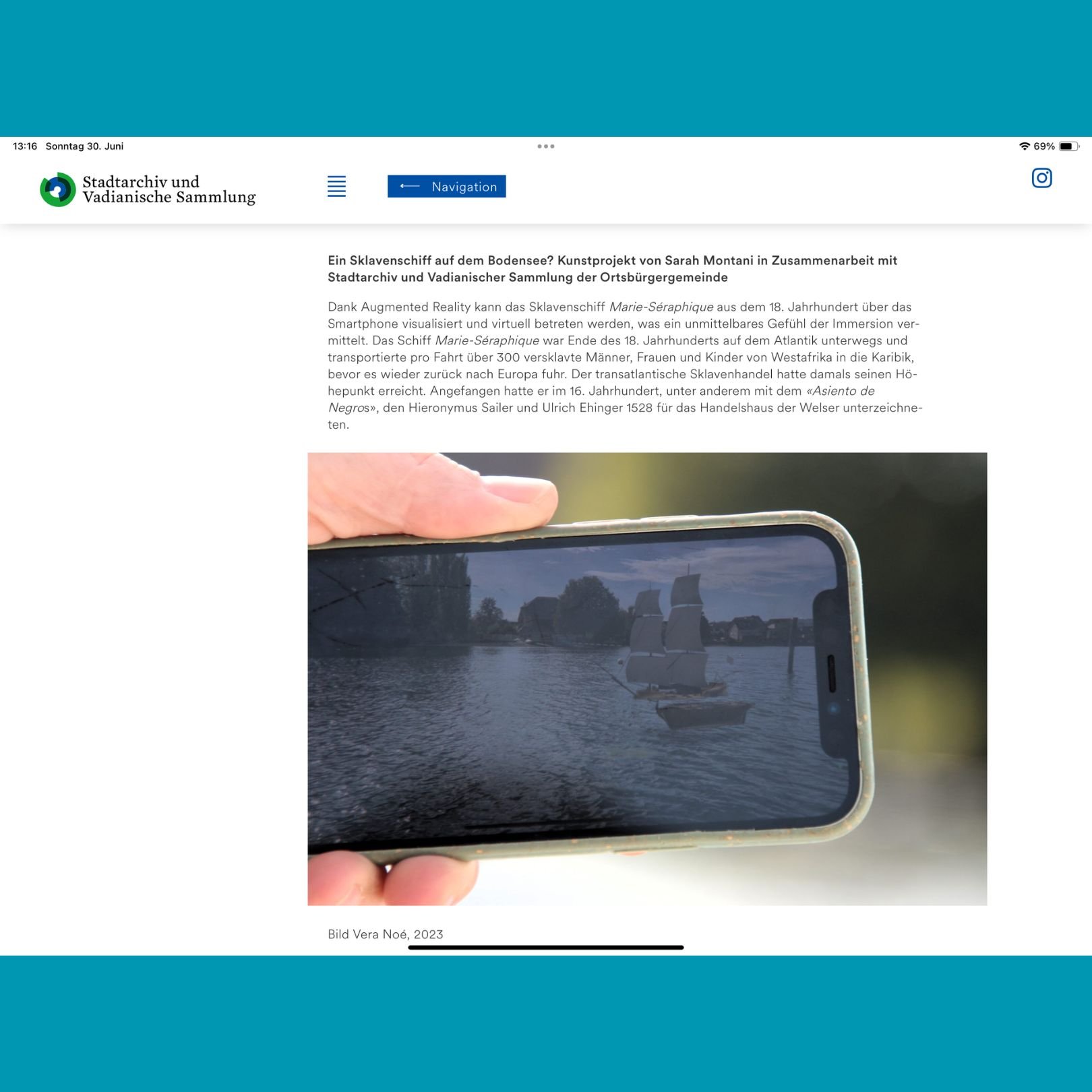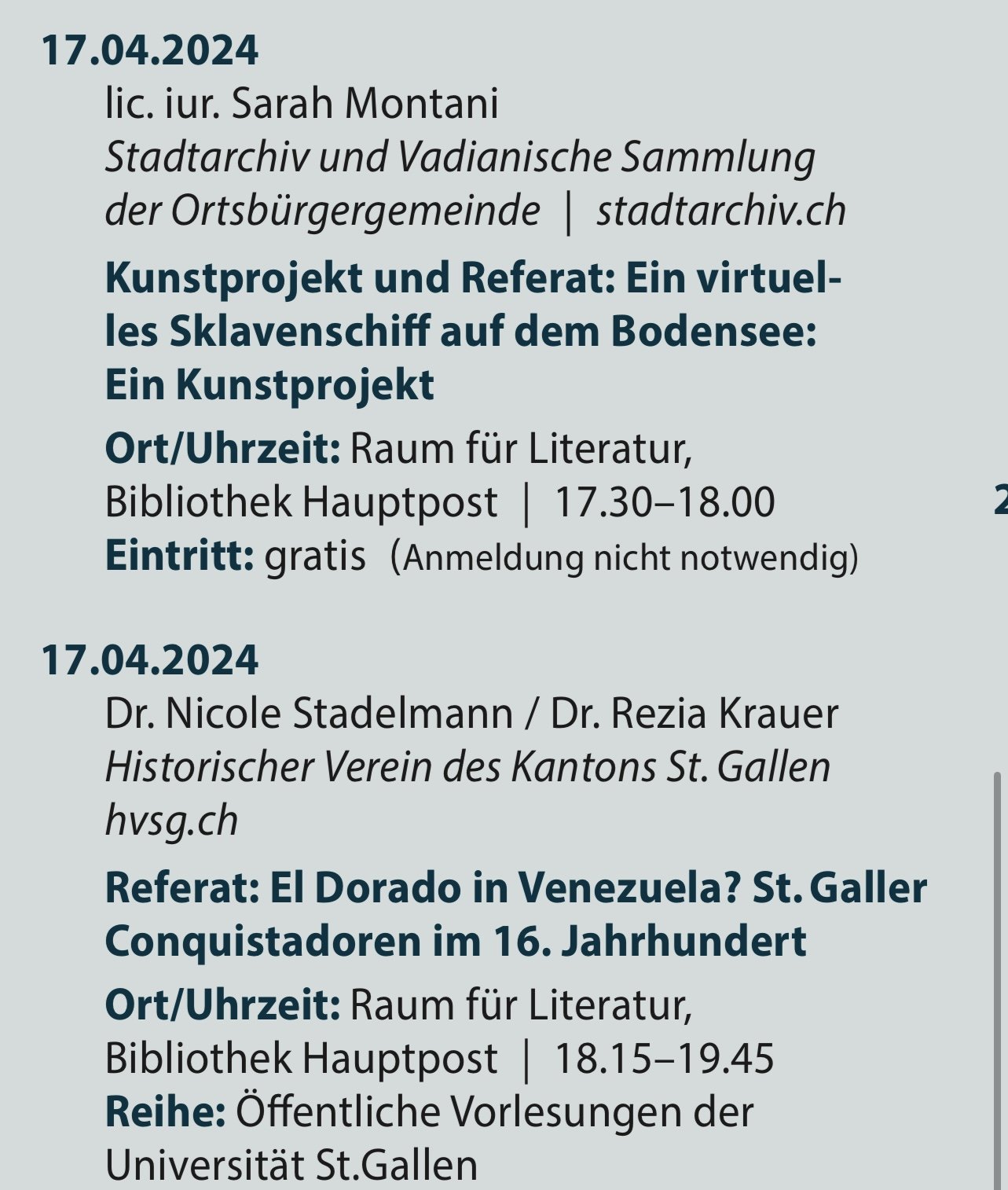
History Live
Sarah Montani X City Archive and the Vadian Collection St. Gallen
Live History through Technology: A Slave Ship Brought to Life in Augmented Reality
The original ship was realized by SlaveVoyages and the Emory Center for Digital Scholarship, Ian Burr. It is the property of SlaveVoyages and the Emory Center for Digital Scholarship.
Sarah Montani worked on it with Jamie F.G to realize a augmented reality version for the exhibition at Lake Constance. This model may not be copied or used without the explicit and writen premission of SlaveVoyages and Emory Center for Digital Scholarship. The 3D model should not be redistributed outside the Project 2024 Lake Constance exhibition. It is not permited to show this modell at other venues without explicit consent of SlaveVoyage Team. The Emory Center for Digital Scholarship (ECDS) and SlaveVoyages shall be credited where the model is used in this project.
The model that was shown during the exhibition is no longer available after the exhibition.
We have uploaded a new model for you so that you can still get an idea of the exhibition.
Make it stand out.
View the Slave Ship Marie-Séraphique in Augmented Reality. Via smartphone, the ship can be visualized and "entered", offering an immediate feeling of immersion. Viewers can perceive the inhumanly cramped conditions in the ship's hold where people were packed tightly together, every available space of the lower deck was utilized to maximize the profit from human trade.
Go to the Website of Stadtarchiv: https://stadtarchiv.ch/forschungsprojekte/konquistadorenundsklavenhaendler/
Here some impressions of the Bookvernissage and the speech of Sarah Montani and Dr. Nicole Stadelmann and Dr. Rezia Krauer in St. Gallen, Swizterland.
View now.
Book &
&
AR Sculpture
Scan
Scan the QR-Code to view the 3D model in augmented reality
The original ship was realized by SlaveVoyages and the Emory Center for Digital Scholarship, Ian Burr. It is the property of SlaveVoyages and the Emory Center for Digital Scholarship.
Sarah Montani worked on it with Jamie F.G to realize a augmented reality version for the exhibition at Lake Constance. This model may not be copied or used without the explicit and writen premission of SlaveVoyages and Emory Center for Digital Scholarship. The 3D model should not be redistributed outside the Project 2024 Lake Constance exhibition. It is not permited to show this modell at other venues without explicit consent of SlaveVoyage Team. The Emory Center for Digital Scholarship (ECDS) and SlaveVoyages shall be credited where the model is used in this project.
The model that was shown during the exhibition is no longer available after the exhibition.
We have uploaded a new model for you so that you can still get an idea of the exhibition.
Augmented reality
The Book.
Get the Book from the Exhibition.
Amazon: https://www.amazon.de/Konquistadoren-Sklavenh%C3%A4ndler-vom-Bodensee-Kolonialgeschichte/dp/3038950610
"Identity and Live History through Technology: A Slave Ship Brought to Life in Augmented Reality"
An impressive piece of history is brought to life: A slave ship once built for the transatlantic triangular trade is now available in Augmented Reality (AR). The ship is showcased during a themed month that reveals the colonial history and involvement of merchants from St. Gallen and Konstanz in the transatlantic trade of raw materials from the colonies and enslaved individuals. It's a collaboration between Dr. Nicole Stadelmann and Dr. Rezia Krauer from the City Archive and the Vadian Collection St. Gallen, Prof. Dr. Kirsten Mahlke and M.A. Hannah Beck from the University of Konstanz. The AR installation was crafted by Swiss artist Sarah Montani in collaboration with Joey Montani and Jamie F.G, supported by Joël Herde from the St. Gallen company Futurise GmbH.
Modern Slavery, the inhuman continuity of an age-old crime
The project underscores the connection to modern slavery and emphasizes the persistence of this horrifying crime against humanity in today's world. More than 50 million people are living in conditions like forced labor and forced marriage today, whether as domestic or factory slaves, as sex workers or forced laborers, with women and children especially at risk. Augmented Reality technology serves as a bridge, connecting past and present, and creating a memory of one of the most disturbing and deeply-rooted issues of our time, slavery.
The artist draws parallels between the AR ship and the philosophical puzzle of "The Ship of Theseus". It delves into the theme of identity and change by asking whether we should regard the past as a closed chapter or as a past that extends into the present and with which we can engage in dialogue. "Connecting with the past helps us better understand and reflect on our current self. Just as the Ship of Theseus illustrates that identity is not static but in flux, the AR ship demonstrates that our connection to history is not abstract but a vibrant, malleable part of who we are. It invites us to view the past not just as a closed chapter, but as an ongoing dialogue shaping our current lives," Montani says. The AR ship can be accessed via a QR code and explored for free, offering valuable educational insights for personal reflection, history lessons, and stands as a powerful symbol for the continued exploration of one's own identity and history.
"Live History: Slave Ship Marie-Séraphique Brought to Life in Augmented Reality"
What is Augmented Reality? Augmented Reality, at the intersection of physical reality and digital simulation, allows for computer-generated information, objects, or representations to be integrated into the real environment, resulting in a fusion of the real and virtual world. Unlike Virtual Reality, which immerses the user entirely in a virtual environment, Augmented Reality enhances physical reality by enriching the user's perception with additional digital information.
Expert Ivan Sutherland once said, "The ultimate screen is space itself." A digital representation is typically constrained by the screen, hence being a 2D depiction. With Augmented Reality, the digital object is embedded in our surroundings, appearing in 3 dimensions.
A crucial aspect of Augmented Reality requiring cultural sensitivity is how this technology is introduced into various cultural contexts. In this project, a slave ship is depicted and reinterpreted. The ship can be accessed on any smartphone via a QR code for free and subsequently explored.
The complexity of Augmented Reality doesn't lie solely in its technological implementation but also in the ethical, cultural, and social questions it raises. The artist spent a long time grappling with how enslaved individuals could be depicted with dignity. She chose to utilize historic sketches of the ship from 1770 and displayed them in the slave deck. One person is depicted standing to highlight that enslaved individuals didn't have the room to stand upright.
The ship is shown divided, representing that such crimes against humanity should no longer exist – as the ship is rendered unseaworthy in this state. With daily images reaching us about migration across the Mediterranean, the issue intensifies. By mid-2023, already 100,000 individuals, including unaccompanied minors, arrived in Italy – the highest since 2017. There were also more deaths, with over 2,000 individuals having drowned in the Mediterranean by mid-2023, nearing 30,000 since 2014.
Overall, Augmented Reality presents itself as a multifaceted and fascinating subject, intertwining technology, history, art, sociology, and ethics. Understanding it demands not just technical knowledge but also an awareness of the broader contexts in which it exists and operates.
Project Team
Communication: Dr. Nicole Stadelmann and Dr. Rezia Krauer from the City Archive and the Vadian Collection St. Gallen.
Historical validation: Prof. Dr. Kirsten Mahlke and M.A. Hannah Beck from the University of Konstanz.
Technical execution: Sarah Montani, lic.iur., Artist and Digital Pioneer, in collaboration with Joey Montani and Jamie F.G, and the company Futurise GmbH St. Gallen.
Special Thanks to SlaveVoyages and Emory Center for Digital Scholarship. Ian Burr (Foto bellow) from Emory Center for Digital Scholarship, Robert W. Woodruff Library rm 310, Emory University.
The original ship was realized by SlaveVoyages and the Emory Center for Digital Scholarship, Ian Burr. All rights belong to SlaveVoyages and the Emory Center for Digital Scholarship. Credit: SlaveVoyages and the Emory Center for Digital Scholarship
We worked on it with Jamie F.G to realize a augemnted reality version for Vadianische Sammlung and Ortsbürgergemeinde St. Gallen.

“Slavery is a Crime against Humanity.”
— Sarah Montani











